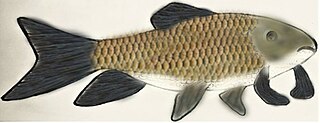
The Green River is a dam-release river that flows through the mountains of North Carolina, south of Asheville. The Green has numerous tributaries, but much of its water flows from a confluence with Big Hungry Creek. The Green River is itself a tributary of the Broad River. The river is dammed to form Lake Summit, in Tuxedo, North Carolina, and Lake Adger near Mill Spring, NC. The Green River is named for its deep green color but runs brown after heavy rains.

The black redhorse is a species of freshwater fish endemic to Ontario and the eastern half of the United States, where it lives in streams and small to medium rivers.

The golden redhorse is a species of freshwater fish endemic to Ontario and Manitoba in Canada and the Midwestern, southern, and eastern United States. It lives in calm, often silty or sandy waters in streams, small to large rivers, and lakes.

The greater redhorse is a species of freshwater fish found in northeastern North America. It is the largest member of the genus Moxostoma, with a maximum length of 80 cm (31.5 in).

The river redhorse is a species of freshwater fish endemic to the eastern half of the United States and southeastern Canada. They can range from 10 to 30 inches in length and can potentially reach a weight of more than 10 pounds after maturity. It is typically found in clear, large creeks and rivers, though it is sometimes also found in lakes. They are sometimes speared or caught with hook and line using crayfish or worms as bait.

The shorthead redhorse is a wide-ranging species in North America. The shorthead redhorse is native to central and eastern North America. However, its range has expanded to include areas like the Hudson estuary and Grayson County, Texas. It inhabits small to large rivers and lakes, and lives in the benthic zone. Shorthead redhorse feed on benthic invertebrates and can consume plant material from the benthic environment that it inhabits. When it spawns, shorthead redhorse move into more shallow streams and spawn over gravel or rocky shoals. They will also spawn in springs with swift moving water. The shorthead redhorse is important to humans because it is a game fish. It is also important to anglers because of its role in the ecosystem; it is prey for larger game fish such as northern pike and muskellunge.

The silver redhorse is a species of freshwater fish endemic to Canada and the United States. Sometimes called redhorse or sucker for short, it is in the family Catostomidae with other suckers. The species is distributed from Quebec to Alberta and is also in the Mississippi River, St. Lawrence River, Ohio River, and the Great Lakes basins. The current world record is 14 pounds, 14 ounces, caught by Chris Stephenson on Pickwick Lake in Alabama, April 1995 and certified by National Freshwater Fishing Hall of Fame.
Rough fish is a term used by some United States state agencies and anglers to describe fish that are less desirable to sport anglers within a defined region. The term usually refers to larger game fish species that are not commonly eaten, are too rare to be commonly encountered, or are not favorably sought by anglers for sporting purposes. Many of these species are actually very important in the commercial fishing industry, where they make up the bulk of commercial food fish catches in inland freshwater bodies.

Moxostoma, the redhorses or jumprocks, is a genus of North American ray-finned fish in the family Catostomidae.

The gray redhorse is a species of freshwater fish in the family Catostomidae. It is found in Mexico and the United States.

The copper redhorse is a North American species of freshwater fish in the family Catostomidae. It is found only in Canada.

The harelip sucker was a species of ray-finned fish in the family Catostomidae. It was found only in the United States. It is considered extinct as it has not been seen alive since 1893.

The robust redhorse is a redhorse-type fish that lives in the freshwater streams of the eastern United States. It was previously called the smallfin redhorse.
The Prairie River is a river in Itasca County, Minnesota. The river is located in northern Minnesota, near the communities of Taconite, Bovey, Grand Rapids, and La Prairie. It is a tributary of the Mississippi River.
Smallmouth redhorse is a species of ray-finned fish in the genus Moxostoma.
The notchlip redhorse is a species of ray-finned fish in the genus Moxostoma.

The pealip redhorse is a species of ray-finned fish in the genus Moxostoma.

The blacktail redhorse is a species of ray-finned fish in the genus Moxostoma. The blacktail redhorse occupies North America, being located throughout Mississippi River tributaries on the former Mississippi Embayment, ranging from Southern Kentucky to Galveston Bay in Texas.

The white sucker is a species of freshwater cypriniform fish inhabiting the upper Midwest and Northeast in North America, but it is also found as far south as Georgia and as far west as New Mexico. The fish is commonly known as a "sucker" due to its fleshy, papillose lips that suck up organic matter and aufwuchs from the bottom of rivers and streams.
















